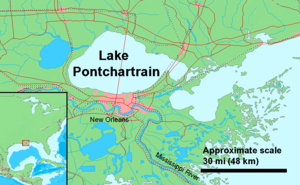Lake Pontchartrain
Template:Infobox Lake/Maintenance/REFERENCE-SURFACETemplate:Infobox Lake/Maintenance/REFERENCE-MAX-DEPTHTemplate:Infobox Lake/Maintenance/REFERENCE-MED-DEPTH
Lake Pontchartrain (English Lake Pontchartrain [leɪkˈpɑːntʃətɹeɪn]) in southeastern Louisiana is a brackish water lake and the second largest saltwater lake in the United States after the Great Salt Lake.
The lake is largely oval with an east-west extension of about 64 km, a north-south extension of 38 km, an area of 1839 km² and an average depth of 3.65 m to 4.26 m (partly artificially deepened along shipping routes). It is thus about three times as large as Lake Constance. To the south is New Orleans, to the north Mandeville and Madisonville, to the northeast Slidell. To the west Lake Pontchartrain is connected by a canal with Lake Maurepas; to the east by the Rigolets with Lake Borgne, a lagoon of the Gulf of Mexico. The salinity of the lake varies - depending on the location - from "negligible" to half the normal oceanic salinity.
In some Native American languages, Lake Pontchartrain was called Okwa-ta ("Wide Water"), also in the language of the Houma people who had settled on adjacent Bayou St. John. The lake received its present name in 1699 from the French explorer Pierre Le Moyne d'Iberville in honor of Louis Phélypeaux de Pontchartrain, at that time French Minister of the Navy and Chancellor.
Lake Pontchartrain is not actually a lake or a reservoir, but a lagoon. The lower lying city of New Orleans is protected from flooding by the lake by dikes up to six meters high.
Lake Pontchartrain and other lakes form the Mississippi River estuary. This drains the Pontchartrain Basin, a 12,000 km² area on the eastern (left) side of the river. One-third of Louisiana's population resides in this basin. The lake serves as a diverse recreational area.
Lake Pontchartrain gained worldwide notoriety when several levees broke on August 30, 2005 during Hurricane Katrina, submerging New Orleans. One of the levee breaches occurred directly on the lake shore, while others occurred along several canals (Industrial, 17th Street, and London Street Canal) that connect the lake to the city's interior. The length of the levee breach was first reported as 50-60 m, later as 91 m. It was not until about a week later that the leaks were plugged by the United States Army Corps of Engineers, the Army's engineer corps.

Lake Pontchartrain, USA
Development of traffic across the lagoon
Still under Spanish rule over Louisiana, the Carondelet Canal was dug in 1794, from the lagoon to what was then still French New Orleans. Then, until the late 19th century, Lake Pontchartrain remained an important waterway and had several harbors. One remnant of the harbors is the Port Ponchartrain Lighthouse, the 1855 lighthouse to the port of the defunct resort town of Milneburg. It served as offices for the Ponchartrain Beach & Amusement Park after its beacon went out in 1929, until the amusement park also disappeared in favor of a technology park at the old tower.
On February 25, 1964, a Douglas DC-8 commercial aircraft of Eastern Air Lines Flight 304 crashed into the lagoon on approach to the lakeside Lakefront Airport. All 58 occupants were killed, including singer and actor Kenneth Spencer and French feminist Marie-Hélène Lefaucheux.
A 40 km long double bridge crosses the lake, connecting New Orleans with Covington since 1956. The newer of the two bridges, the Lake Pontchartrain Causeway II, opened in 1969. The bridge is the tenth longest bridge in the world. The lagoon flooding associated with Hurricane Katrina in 2005 dislodged several of the bridge's roadway-supporting concrete elements from the bridge piers as they floated on the water masses. The structural failure was that a large enclosed air cavity was created under some bridge elements, which increased the buoyancy caused by the water masses. The bridge was repaired a short time later, as it is one of the most important access routes to the port city of New Orleans.
There is also an overhead high voltage power line across Lake Ponchartrain, with pylons on caissons. It is considered an example of illustrating the curvature of the earth.
Environment and nature
The lake is home to more than 125 species of lake or aquatic life - including anchovies, sharks and alligators. The surrounding wetlands are inhabited by otters, wild boar, ducks and eagles.
Until 1991, raw materials for cement and asphalt were dredged from the lake bed.
Lake Pontchartrain has long suffered from environmental pollution; pumping out the city of New Orleans after Hurricane Katrina released large amounts of polluted water into the lake.
Search within the encyclopedia